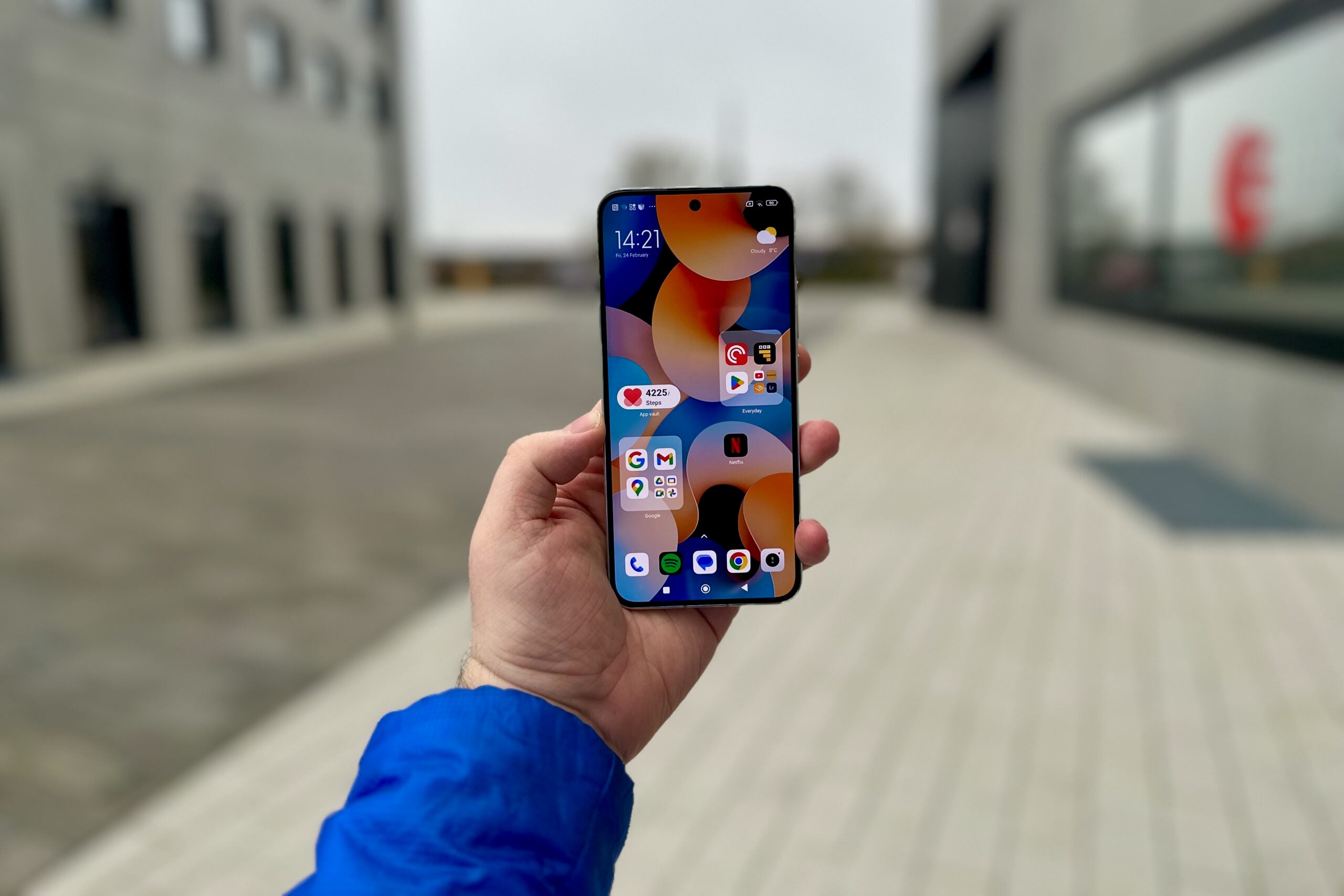Your smartphone is probably the single most important bit of tech that you own, providing not only a way to call and text friends and family but a way to take photos and videos, play games and browse the internet, and the tech that powers them improves all the time. That also means that it can be difficult to work out which smartphone best suits your needs when you want to upgrade.
That’s where the expert team at Trusted Reviews come in. We regularly test smartphones of all shapes and sizes, from budget to extremely high-end, and we know exactly what a smartphone needs to be considered the best of the best.
We’re also aware that customers are looking for different attributes in a phone. Some want excellent performance levels to play the latest games, some want the best cameras to capture special life moments, and some want a battery that can last for hours and hours on end. And of course, many of you will want all of these advantages in the same device.
That’s why we’ve made sure that our list covers a true variety of phones made by different manufacturers, with both iPhones and Android phones being featured on this list.
We also have curated other best lists if you’re looking for something a little more specific. Our best camera phone round-up focuses on a device’s photographic and videography skills, while our best cheap phone and best mid-range phone lists focus solely on more affordable options depending on your budget.
Which is the best smartphone 2023?
How we test
Every phone included in the below list has been properly tested and used for an extended period by one of our product experts. We don’t review phones based purely on specs or a manufacturer’s claims – we use them as our everyday devices for at least five days and usually for much longer.
If you read a phone review on Trusted Reviews, you’ll know the reviewer has popped their personal SIM card into the phone, transferred across their most-used apps and even their backlog of WhatsApp messages. We go all in, so you know you’re getting an honest view of a product.
Our review process includes a mixture of real-world tests, along with more than 15 measured tests and industry-standard benchmarks. We believe this gives the most rounded view of a device. The scores a phone receives from a run under our professional colourimeters aren’t worth much if the screen can’t be used comfortably on a sunny day.
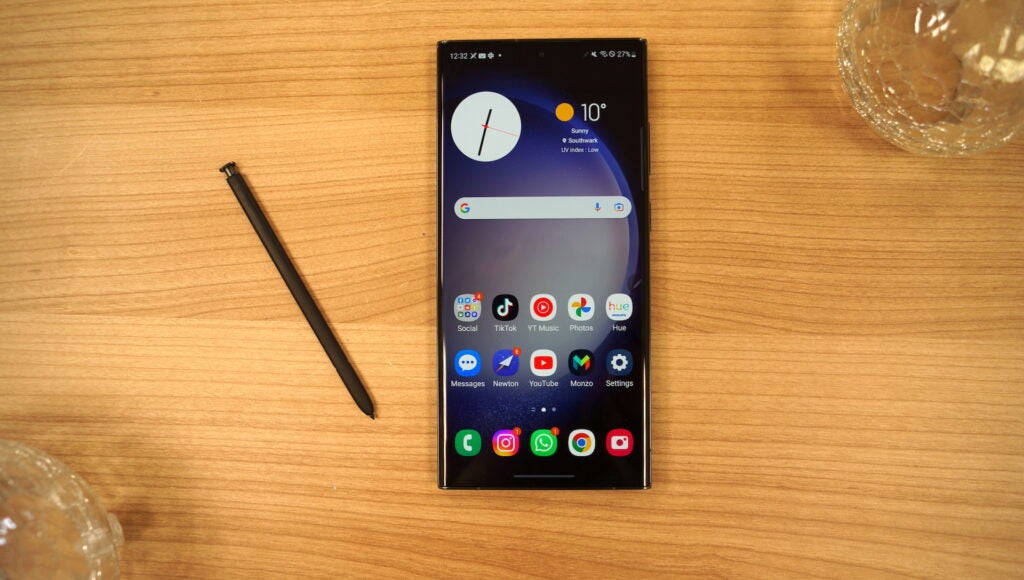
Samsung Galaxy S23 Ultra
The best flagship Android phone
Pros
- 200MP camera delivers in both well-lit and low-light conditions
- Top-notch performance from the Snapdragon 8 Gen 2 for Galaxy
- All-day battery life
- Stunningly detailed 6.8in 120Hz display
Cons
- Very expensive
- Relatively slow 45W charging
- Difficult to use one-handed
Samsung’s 2023 flagship is here in the form of the Galaxy S23 Ultra, and it has taken the top spot in our list of the best phones you can buy right now. Our expert reviewer felt that while the phone is certainly big, it shines thanks to an unmatched camera, stunning display, an included S Pen and very good battery life.
The star of the show, and the biggest upgrade over the outgoing S22 Ultra, is the new 200MP main rear camera. The snaps our expert tester pulled out of this phone show clear improvements over the iPhone 14 Pro and Pixel 7 Pro, with swathes of detail in all manner of conditions. Low-light performance is sublime, with our reviewer claiming it gave him extra confidence to pull off any shot he wanted.
Battery life was a bit of a concern with the Galaxy S22 Ultra, falling below the iPhone 14 Pro Max by a considerable margin. We were much more impressed with the S23 Ultra, having no issues getting through a busy day with over 20% left when it came to bedtime. With the physical battery being the same as before, a lot of this optimisation will come down to the next chip. For the first time in a number of years, Samsung is using the same chipset worldwide – ensuring everyone gets the same feature set.
The Qualcomm Snapdragon 8 Gen 2 for Galaxy performs well, even if it’s not quite as quick in benchmark tests as the iPhone 14 Pro series. Still, we had no qualms and it ran intensive games and apps with ease.
Elsewhere the phone remains similar to its predecessor, which is no bad thing. It’s large (which might put some off), with a gorgeous 120Hz display complete with S Pen support for quick doodles and notes.
Of course, one of the big things holding the S23 Ultra back is the price. If you want a slightly cheaper – but still very capable – Android superphone then the outgoing Samsung Galaxy S22 Ultra remains an admirable performer if you can find it at a heavy discount. There’s also the more modest Galaxy S23 and Galaxy S23 Plus – although these do miss out on the big camera upgrades and S Pen support.
Reviewer: Lewis Painter
Full review: Samsung Galaxy S23 Ultra review
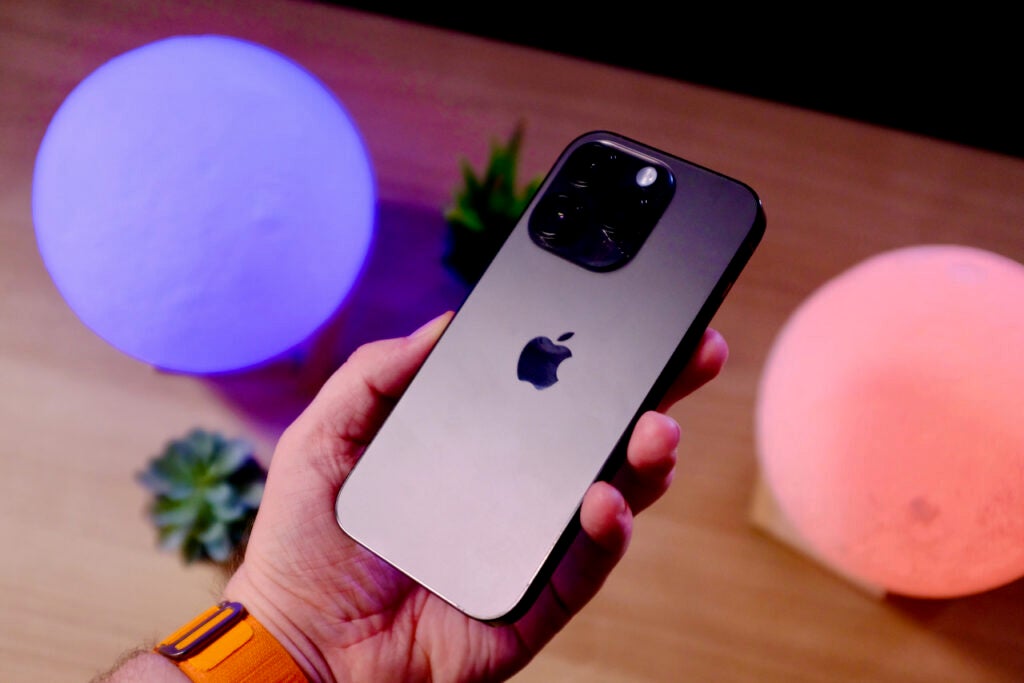
iPhone 14 Pro
The best iPhone
Pros
- Great screen that gets very bright outdoors
- Versatile camera system for both photography and videography
- Always-on display and Dynamic Island are both neat tricks
- Additional safety features are always welcome
Cons
- Not the quickest to charge
- Zoom photography isn’t on the level of the competition
- Only really a day of battery life
If you’re looking for a true flagship phone and want iOS, as opposed to Android, you’re going to be looking at the iPhone 14 Pro – the current best iPhone on the market.
For the first time, the Pro model of the iPhone 14 line feels like a true step forward over the modest iPhone 14. This is where the true innovations lie, from the clever Dynamic Island that finally makes sense of the notch to the first always-on display on an iPhone.
The Dynamic Island caught the eye when the iPhone 14 Pro was first announced, not least because of the slightly silly name. In practice it works very well, turning the notch into a sort of secondary interaction zone where your currently playing song and timers go. The functionality will only improve once the developers have access to it and I am sure we will see something similar from Android makers in the coming months.
The camera is another big upgrade. Like the Samsung Galaxy S22 Ultra and the majority of Android phones on this list, the camera uses the high megapixel (in this case 48-megapixels) sensor to combine multiple pixels into one, giving you 12-megapixel images. The results are mostly great and, some oversharpening aside, stand out as the best pictures from any smartphone. The Samsung Galaxy S22 Ultra is the best choice for zoom though, and we still think the Pixel 6 Pro captures more natural and realistic skin tones.
When it comes to video the iPhone is the true star though, easily capturing the finest footage on test. Add in the new Action Mode that improves stabilisation and you’ve got the best phone for videography we’ve tested.
The screen is also the brightest and best we’ve tested, while the performance skills here are comfortably above the Android competition. Battery life is good too, though the charging speeds pale in comparison to phones from Oppo, OnePlus and Xiaomi.
Reviewer: Max Parker
Full review: Apple iPhone 14 Pro review
Google Pixel 7 Pro
The best software
Pros
- Excellent camera and loads of clever camera tricks
- The best version of Android on the market
- Priced well for the European market
Cons
- Charging could, and should, be faster
- Very glossy finish and some odd design elements
- Not a huge upgrade on the Pixel 6 Pro
The Google Pixel 7 Pro is a fantastic Android phone that undercuts rivals like the Samsung Galaxy S22 Ultra when it comes to price, without ditching too many features.
Google’s latest flagship, launched alongside a smaller Pixel 7 model, ticks just about all the boxes our reviewers look for in a phone that ends up on this list. It has a great screen with a smooth 120Hz refresh rate, a sleek design, capable internals thanks to the Tensor G2 and battery life that matches up to phones like the Samsung Galaxy S22 Plus.
But there are really two areas where the Pixel 7 Pro stands out. First of all – the camera. Our reviewer was very impressed with the photography skills of this phone, praising its true-to-life skin tones, colours and landscape reproduction. It handles skin and pictures of faces better than the iPhone 14 Pro, or Samsung Galaxy S22 Ultra.
There are lots of software tricks in the camera app too, many utilising the AI skills of the Tensor G2 chipset. You can remove unwanted elements from snaps, be it people or objects, and smooth out blurry shots.
The rest of the phone’s software is great too. It’s not as buggy as previous Pixel phones and feels clean, smooth and quick to use.
Reviewer: Max Parker
Full review: Google Pixel 7 Pro Review
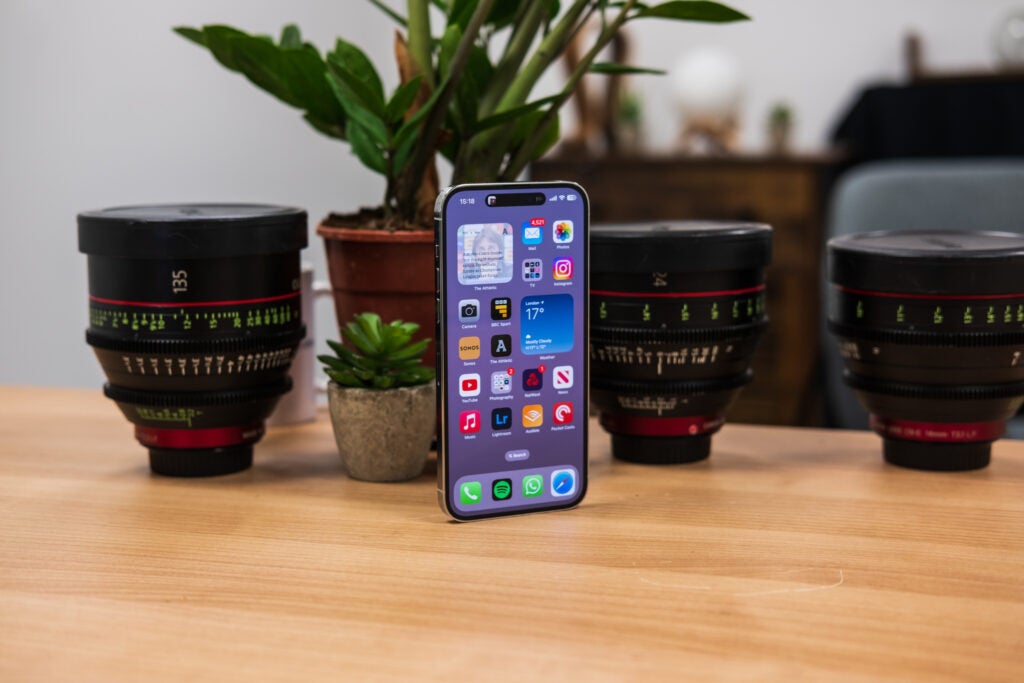
iPhone 14 Pro Max
The best big iPhone
Pros
- Stunning display
- Performance that should stay fast for a long time
- Reliable cameras in all conditions
- Long battery life
- Dynamic island is a great idea
Cons
- No big zoom camera improvements
- Uncomfy design without a case
If you’re looking for an iPhone that not just gets everything done but also offers you a lovely big screen to enjoy as well, then your best bet would be the iPhone 14 Pro Max. With this 6.7-inch OLED display, we found especially that HDR-supported content from the likes of Netflix or Disney Plus looked simply brilliant on this panel, which also gives so much more space to get immersed in your games.
Of course, with such a big screen then you’ll have to be ready to handle this handset’s bulkier profile as well, and it measures a healthy 240g which is far from featherweight.
This device has far more to offer than just its large screen. The camera is both brilliant and versatile, with three lenses on the rear, and it’s powerful too thanks to its muscular new A16 Bionic chipset. What’s more, the battery life is very generous too, making this device the excellent all-rounder that it should be for the price.
Reviewer: Max Parker
Full review: iPhone 14 Pro Max Review
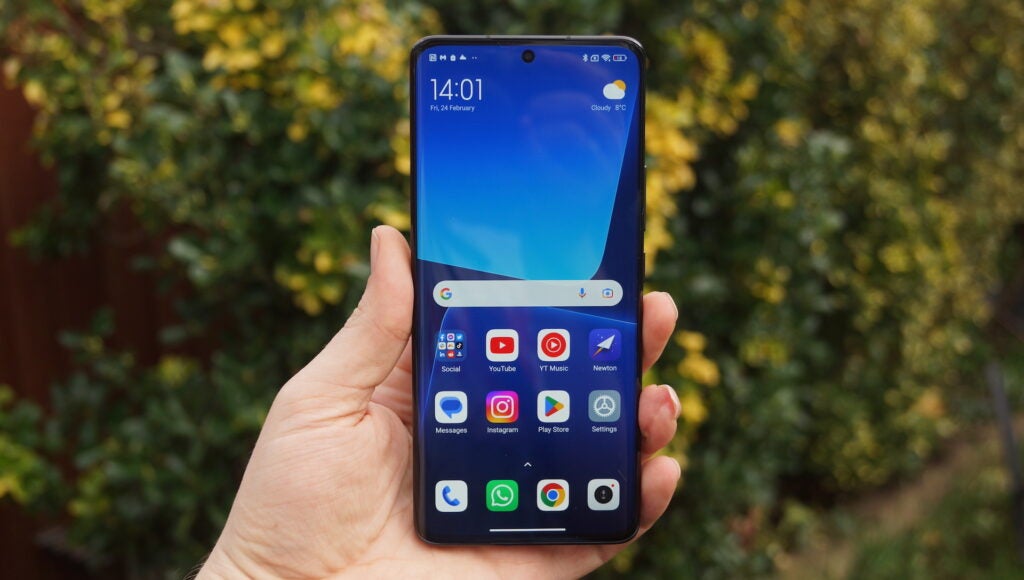
Xiaomi 13 Pro
The best big Android
Pros
- Premium, high-end design
- Top-end 120Hz AMOLED display
- Capable triple 50MP camera offering
- Rapid 120W fast charging tech
Cons
- MIUI 14 takes a lot of getting used to
- Not as capable in low-light as competitors with a 1-inch sensor
- Plenty of pre-installed apps
While the Samsung Galaxy S23 Ultra technically has the largest display of any phone in this list, it’s made to feel even larger by its boxy design. So much so, in fact, that it’s pretty hard to use one-handed. That’s where the Xiaomi 13 Pro comes in, measuring in at a smidge less at 6.78 inches but with a curvy design that makes it comfortable to hold and use.
It’s not just simply a large display either; it’s an AMOLED panel packed with premium specs including a WQHD+ resolution, LTPO support that allows it to drop down to just 1Hz to save battery life, along with support for HDR10+ and Dolby Vision with the display maxing out at a retina-burning 1900nits when watching the latter.
With all that said, it should come as no surprise that content, especially HDR content, looked absolutely stunning on the Xiaomi 13 Pro, coupled with the vivid colours, deep blacks and excellent contrast on offer from AMOLED panels.
It’s not just a good phone for watching movies on Netflix though; this is Xiaomi’s flagship and its specs reflect this, including a huge 1-inch sensor powering the main rear-facing 50MP camera that delivers truly impressive photography. That’s couple with one of the best 50MP 3x telephoto lenses we’ve ever seen, delivering DSLR-level bokeh effects for both portraits and close-ups, and a 50MP ultra-wide too.
There’s also top-notch performance from the top-end Snapdragon 8 Gen 2, a 5000mAh battery with rapid 120W charging that’ll go from flat to full in 24 minutes as well as 50W wireless charging support.
The only real let-down is Xiaomi’s MIUI 14. It’s not a bad skin – not as bad as it used to be, anyway – but it does come with a notable level of bloatware ranging from the handy (like Spotify) to the downright random (like QEEQ car rental) and UI quirks will take some getting used to too.
Reviewer: Lewis Painter
Full review: Xiaomi 13 Pro Review
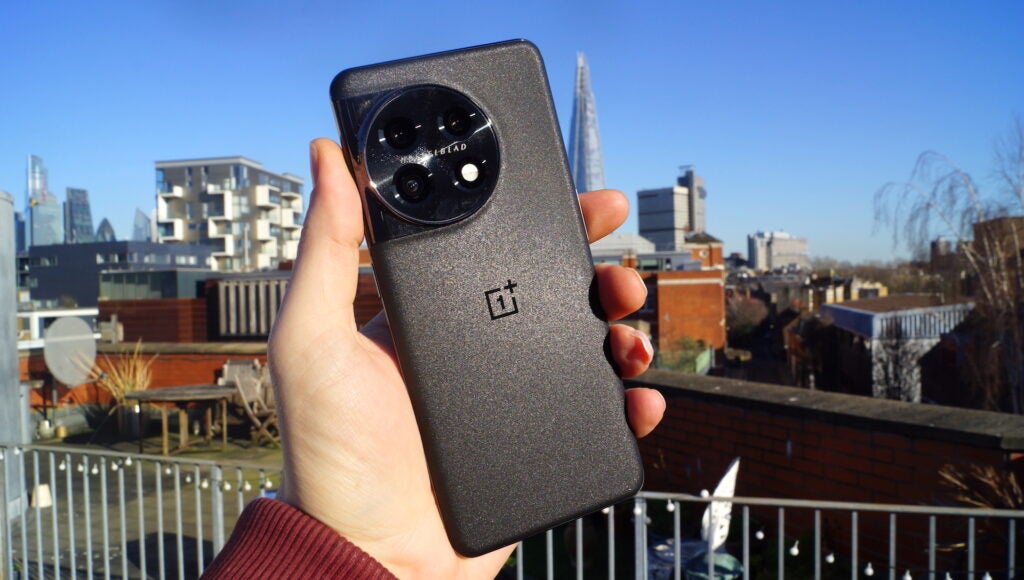
OnePlus 11
The best value
Pros
- Stunning 6.7in AMOLED display
- Solid flagship performance
- Great rear camera performance
- All-day battery life
Cons
- No wireless charging
- Basic selfie camera setup
OnePlus smartphones have been fine, but not particularly exceptional, over the past few years. However, that’s certainly not the case with this year’s OnePlus 11.
The Android flagship offers a competitive range of features at a cheaper price than many rivals featured in this chart starting at just £729. That includes the 6.7in AMOLED display with adaptive refresh rate tech that lets it go as high as 120Hz and as low as 1Hz to provide a buttery-smooth experience that doesn’t come at the sacrifice of battery life. It also boasts support for Dolby Vision and HDR10+, and the slight curvature to the edges helps it sit comfortably in the hand.
It’s more than just a great display though. It boasts Qualcomm’s latest Snapdragon 8 Gen 2 with impressive CPU and GPU performance, a 5,000mAh battery that’ll last all day and then some and 100W SuperVOOC charging that’ll get you from flat to full in less than half an hour. There’s also the benefit of the highly customisable OxygenOS 13, along with OnePlus’ promise of four years of OS upgrades and five years of security updates.
That’s all great but it’s the camera offering that truly stands out. The 50MP main rear snapper is a capable bit of kit able to capture detailed, vibrant images both during the day and at night. In fact, there have been massive gains in low-light photography compared to the OnePlus 10 Pro. Camera tuning is also much better, with a consistent colour pallet across all three rear lenses.
It’s not the perfect phone, lacking popular features like wireless charging and an official IP rating, but it offers one of the best all-round experiences at a price point cheaper than many rivals, making it an easy recommendation in our books.
Reviewer: Lewis Painter
Full review: OnePlus 11 review
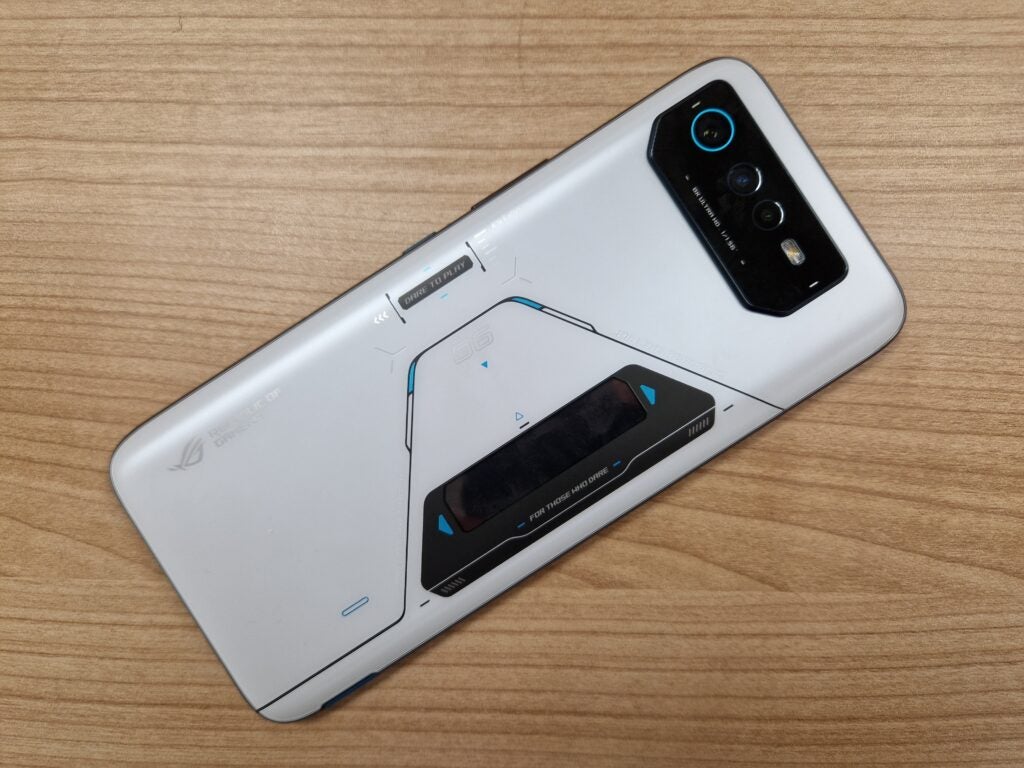
Asus ROG Phone 6 Pro
The best phone for gaming
Pros
- Muscular performance
- Smooth and responsive screen
- Good battery life and fast-charging
Cons
- Cameras aren’t the best
- Not for non-gamers
- Expensive
While the other devices on this list do of course have their own specialities, they remain very strong all-rounders. This one’s a little different in that its raison d’être is purely to be the best at gaming. According to our review experience, it achieved that goal with style to spare.
The Asus ROG Phone 6 Pro offers absolutely scorching performance levels and runs even the most demanding games with an invigorating smoothness, with this quality being further enhanced by the incredible 165Hz refresh rate boasted by the highly capable display. This screen also supports a dizzying 720Hz touch-sampling rate, so you’ll get every possible advantage over your adversaries in competitive multiplayer games.
What’s more, as if the internals weren’t impressive enough, the externals also nail the gaming aesthetic with a small external screen and a confidently stylish look in a fetching white colour, along with support for an array of gaming peripherals (such as a cooling fan) that further enhance the experience.
On the other hand, the camera isn’t quite up to the standards of the other brilliant devices on this list, with the wide angle sensor being good but unspectacular, and the less being said about the underwhelming ultrawide and macro snapper the better. You’d only be advised to buy this phone if you’re an avid gamer who wants nothing but to be the best.
Reviewer: Peter Phelps
Full Review: Asus ROG Phone 6 Pro
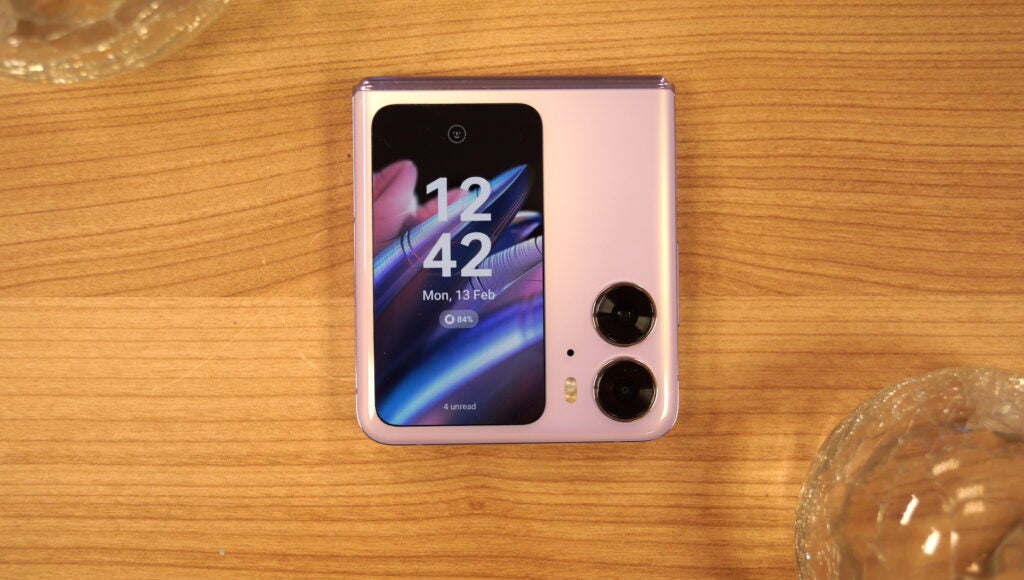
Oppo Find N2 Flip
The best clamshell foldable
Pros
- Most affordable clamshell foldable around
- Gapless folding mechanism
- All-day battery life
- Versatile folding form factor
Cons
- Performance isn’t quite flagship-level
- Less water resistant than rivals
- Software needs some tweaks
- Foldable display can be a fingerprint magnet
The Oppo Find N2 Flip is the latest foldable in the clamshell market, but it’s also the most tempting with a great combination of specs at a lower price than Samsung’s popular Galaxy Z Flip 4.
It starts with a high-end design with small premium touches like the inclusion of a wave-like texture on the spine of the hinge and two gorgeous colour options, the glossy Moonlit Purple and the matte Astral Black. It also closes completely flat unlike Samsung’s option, helping to keep the inner foldable display dust and lint-free.
But for most people it’ll be the large 3.26-inch portrait-orientated outer display that stands out most, dwarfing options from Samsung and Motorola. It offers access to notifications, the time and a range of Oppo-developed widgets to provide quick access to the camera, weather and more, though third-party support is still limited.
Open the phone up and you’ll find a large 6.8-inch foldable OLED panel with a tall, narrow 21:9 aspect ratio. While it boasts premium specs like support for Dolby Vision and a 120Hz refresh rate with LTPO support, it’s the crease – or should we say lack of – that stands out most. It’s the least-visible crease we’ve seen so far, and there’s only a slight bump when you run your finger over it.
Throw in other key specs including the premium (but not quite top-end) MediaTek Dimensity 9000+, a large 4300mAh battery with 45W charging and a decent dual 50MP & 12MP camera setup and you’ve got the best clamshell around at a very tempting price.
Reviewer: Lewis Painter
Full review: Oppo Find N2 Flip review
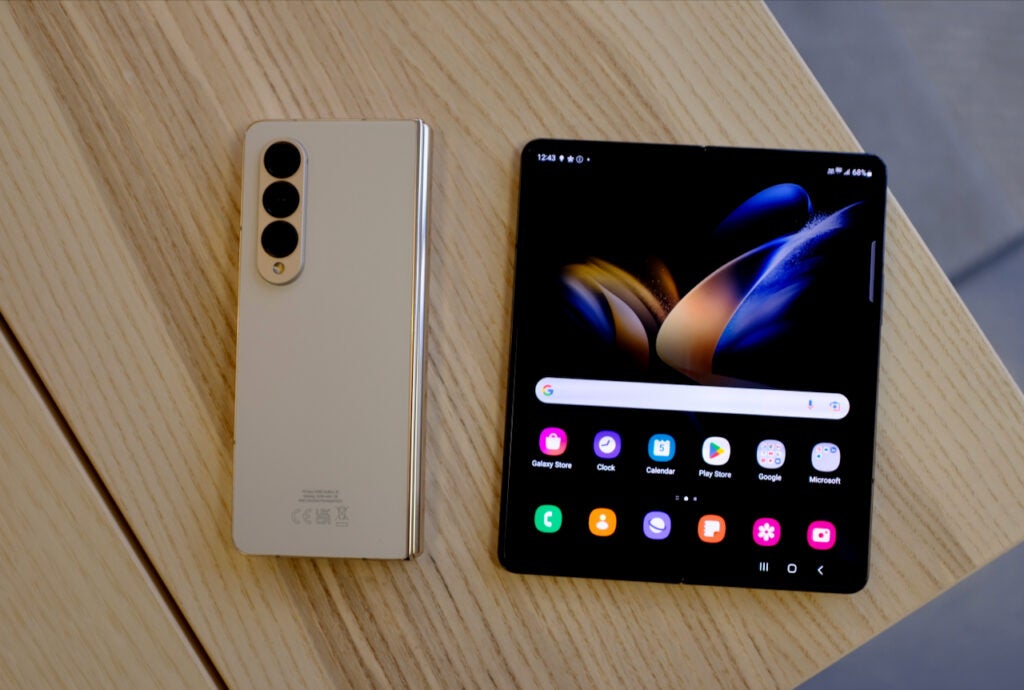
Samsung Galaxy Z Fold 4
The best book-style foldable
Pros
- Smart UI tweaks
- Camera no longer an issue
- The form factor really does work
Cons
- Lack of apps making true use of the big inner screen limits usefulness
- Crease and thick body remain from the previous iteration
- Price still puts it out of reach for most
If it’s a book-style foldable phone you want, the best one we’ve reviewed – by some margin – is the Samsung Galaxy Z Fold 4. It’s not a monumental upgrade over the outgoing model, but it features a number of smaller tweaks that make it the one to choose.
For instance, the camera is no longer a reason not to buy a foldable phone. The triple sensor array on the back of the Z Fold 4 takes pictures that are on par with the Galaxy S22 Plus – something we couldn’t have said about the Z Fold 3. Our reviewer also found it was hard to tell the difference between daylight snaps shot with the Z Fold 4 and Samsung’s other high-end smartphone, the S22 Ultra.
It’s not a perfect camera though. Low-light performance is good, but not on par with the Pixel 6 Pro, while the iPhone 14 Pro captures more pleasing video. The 3x optical zoom is also merely adequate, and not a patch on the Galaxy S22 Ultra.
Of course, the real reason to choose this phone over another on this list is the display. There’s a small panel on the outside, but open the phone up and the 7.6-inch 120Hz OLED panel gives you a full tablet view. The aspect ratio is a lot squarer than you might expect, so you will have black bars around video. Still, it’s great for multitasking and Samsung’s new taskbar lets you flip between apps without heading back to the home screen every time.
The 4400mAh battery got our reviewer through a busy day, even if they did wish the charging situation was a little faster. You’ll need a full 90 minutes to get from 0-100%, which is triple the time required to get a full charge on the OnePlus 10T.
Durability is also worth a look, as previous Fold devices have struggled in this area. This feels like the strongest Z Fold yet. The IPX8 water resistance remains, there’s a stronger Gorilla Glas Victus on the front and the hinge feels sturdy.
Reviewer: Max Parker
Full review: Samsung Galaxy Z Fold 4 review
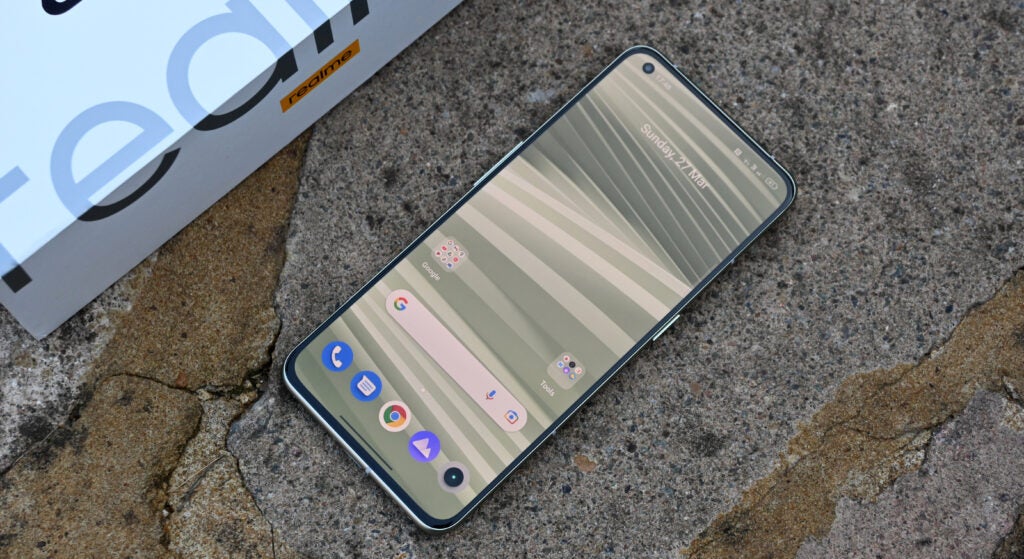
Realme GT 2 Pro
The best mid-range phone
Pros
- Gorgeous display
- Flagship-grade performance
- Excellent battery life and fast charging
Cons
- Lacks a dedicated telephoto camera
- Paper-like design will divide opinion
- No wireless charging or IP rating
If you’re unaware of Realme, then you should sit up and take note of the brand now that it’s launched the GT 2 Pro. For the price, this is a top Android phone that performs just as capable as 2022 flagships like the Galaxy S22 Ultra according to our range of benchmarking tests. Open up a high-spec game on the Realme GT 2 Pro, and it holds its own against much pricier competition.
It’s a similar story again for the display. We put the Realme GT 2 Pro next to the Pixel 7 for comparison, and the 6.7-inch screen here is sharper, smoother when scrolling, and brighter in sunny conditions. It’s not quite on the same level as the iPhone 14 Pro – but we wouldn’t expect that for this price.
In our charge tests, the GT 2 Pro impressed us yet again. Not only is there a charger in the box (unlike the latest handsets from Apple, Samsung, and Sony) but a full 0-100% charge only takes around 30 minutes, which is the fastest out of any of the other phones that make this list.
A couple of sacrifices have been made to hit the desired price, but we don’t consider any one of these to be a dealbreaker. For instance, the rear design lacks the glass finish of some of the top phones (though in its place there’s an innovative paperlike texture), and it doesn’t have the ability to charge wirelessly. More concerning is the lack of IP rating for certified protection against dust and water, and the lack of a telephoto camera for photographic versatility.
Reviewer: Tom Morgan
Full review: Realme GT 2 Pro review
We also considered…
FAQs
Most of the phones included within this list feature a high refresh rate display, either at 90Hz or 120Hz. This means the display refreshes at either 90 or 120 times per second, up from the older standard of 60Hz. Having a fast display makes everything feel a bit smoother, be it swiping through Instagram or gaming. The iPhone 14 with its 60Hz display, for example, simply can’t compare to the smooth scrolling you’ll get from the 120Hz iPhone 14 Pro.
Most new phones, especially those over £400/$400, will now support 5G. This is the next step up from 4G, and provides faster and more reliable download speeds in areas where the network is live. 5G varies by country, with the USA touting a tech called mmWave that has far superior speeds if you’re in the right spot. While 5G isn’t a must-have yet, it’s always good to futureproof your purchases and as most new phones come with the tech now you likely won’t miss out.
There are excellent phones at all price points these days, with the best often costing above a grand if you want the very best. If you aren’t so fussed about things like camera performance and display quality you can get an excellent device for £500/$600.
Comparison Specifications
Here are all the specs for our best phones. Remember, the number of megapixels doesn’t always equal a better camera.
UK RRP
USA RRP
EU RRP
CA RRP
AUD RRP
Manufacturer
Screen Size
Storage Capacity
Rear Camera
Front Camera
Video Recording
IP rating
Battery
Wireless charging
Fast Charging
Size (Dimensions)
Weight
Operating System
Release Date
First Reviewed Date
Resolution
HDR
Refresh Rate
Ports
Chipset
RAM
Colours
Stated Power
Trusted Reviews test data
While test data doesn’t tell the whole story, it’s an important part of our review process. As you can see, the iPhone 14 series is the king when it comes to benchmarks, especially Geekbench, providing top scores.
Geekbench 5 single core
Geekbench 5 multi core
Max brightness
1 hour video playback (Netflix, HDR)
30 minute gaming (intensive)
30 minute gaming (light)
1 hour music streaming (online)
1 hour music streaming (offline)
Time from 0-100% charge
Time from 0-50% charge
3D Mark – Wild Life
3D Mark – Wild Life Stress Test


